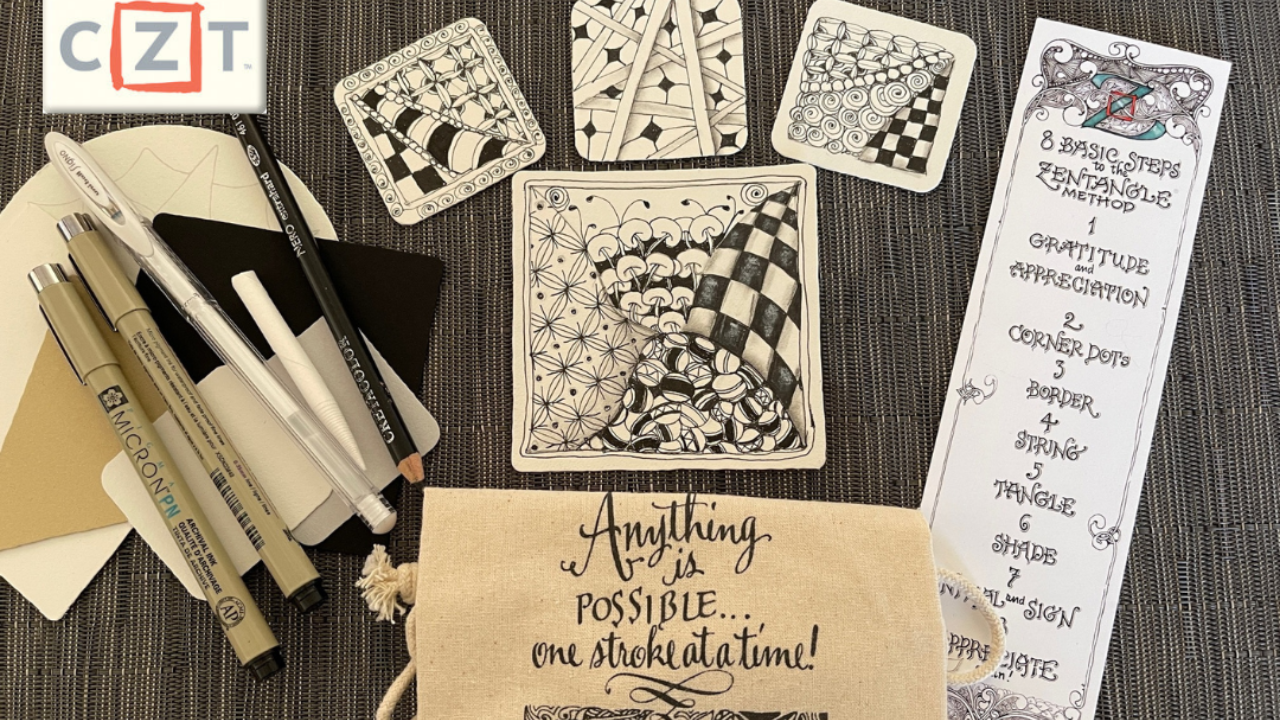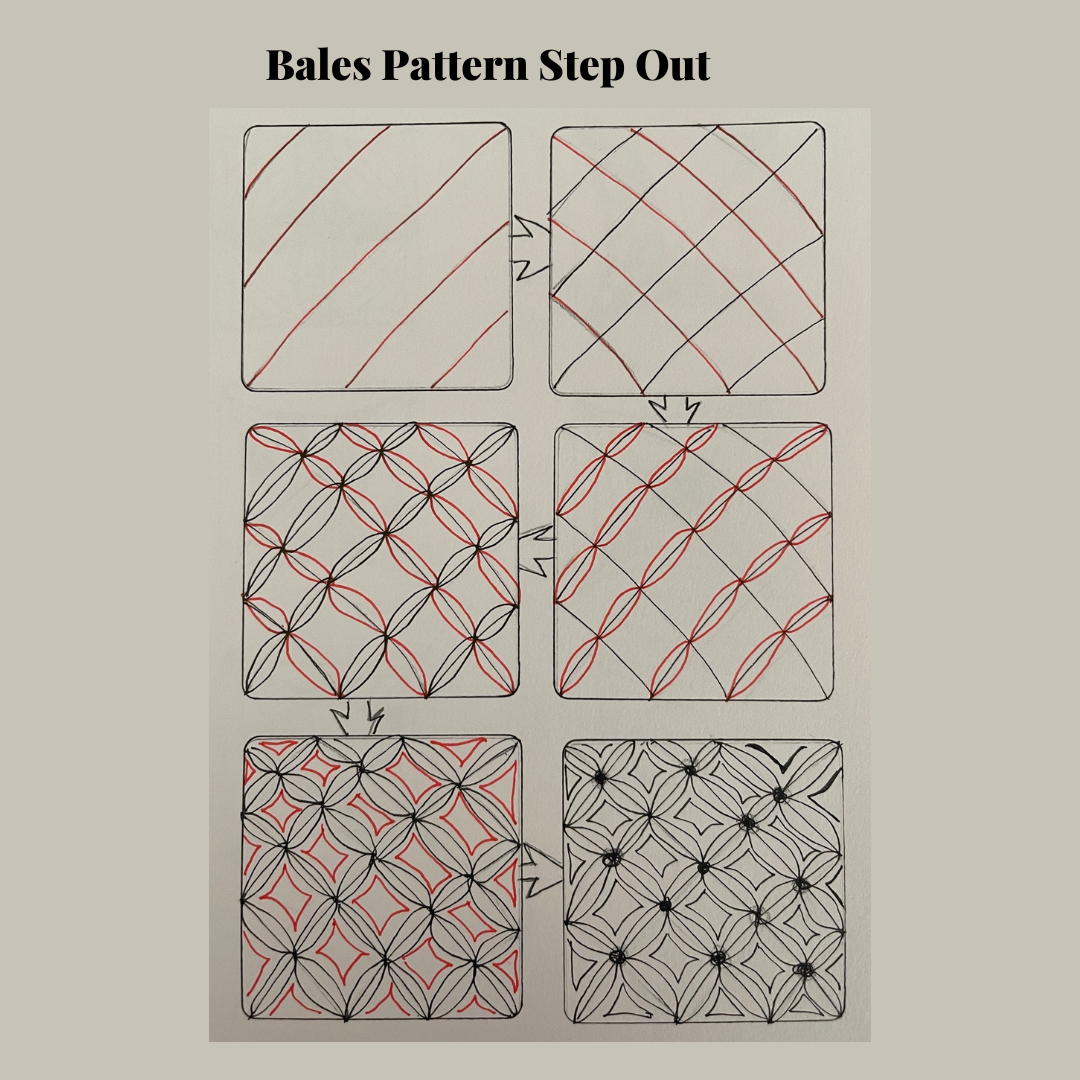
What is Zentangle?

Zentangle is a form of meditative art that involves creating intricate designs using repetitive patterns. It was created by Rick Roberts and Maria Thomas in 2003 as a way to help people focus, relax, and find inner peace through drawing.
The basic technique of Zentangle involves using a pen or pencil to draw abstract patterns on a small piece of paper or card, typically measuring 3.5 inches by 3.5 inches (8.9 cm by 8.9 cm). The patterns are typically black and white, and often involve curved or organic shapes.The process of creating a Zentangle is meant to be relaxing and meditative, with the focus on the repetitive motion of drawing the patterns. Many people find that the practice helps to reduce stress and anxiety, improve concentration and focus, and promote a sense of calm and well-being.
Zentangle is not limited to any specific skill level, and can be practiced by anyone, regardless of artistic ability. There are many resources available, including books, online tutorials, and classes, to help beginners get started with the practice.

Zentangle Method is an art as meditation practice
Zentangle Method was developed as an art meditation. That’s why it works to calm and focus, enhance CREATIVITY, build self esteem and empower non artists to create art.
“The Art of pattern drawing has been around for many many years. Zentangle teaches the art of pattern making as a meditation!” says Maria Thomas, co-founder of Zentangle method in an interview on Youtube with University of Massachusetts students studying the mental health affects of this practice.
Zentangle method was created with the intention in mind to:
- Make people feel good about themselves
- Be creative at the same time
- Make Zentangle accessible to everyone across age and cultures.
The key to this process is the joy you feel when you successfully create your first drawing ever.
It's an easy way to build success upon success incrementally particularly with people who have low self esteem. They don’t think they can create anything. They haven't felt the joy of creating, and say I can’t do that! I can’t draw ✍️. "In just an hour students have created something they knew they couldn’t do.!” says Rick Roberts, co-creator of Zentangle. "Just think of the joyful feelings they must have felt, when they found out there is a way for them to participate in the creative experience.
This can happen to you too. The more we can create with the sense of joy, the more our fears start taking a back seat…
This art form is designed to be super easy!
This art form is designed to be super easy to learn and follows a meditative process that helps you get into the Positive Constructive Day Dreaming, a flow state where you get super focused on some enjoyable activity you like to do and you forget about time and become totally engrossed in your activity like drawing Zentangle.
- Yehudit Steinberg M.Ed. CZT uses this art form for her art as meditation morning practice & throughout the day when needed. "When I feel stressed, or overwhelmed I go to my Zentangle table, in front of my easy chair, turn on some music that fits my mood and start to tangle. Using the method which starts with 10 deep breaths, and a few focusing tools built into the process, my mind begins to quiet
Magical Moments in Zentangle
Zentangle gives you the feeling of special moments that seem magical or even big "Ah ha moments" when you follow the 8 step process of this ritual system. It can help you move into what psychologists describes as flow state of mind. When in this state a person becomes fully immersed in an activity.
- The time flow
- Wonderful surprise or happy accidents
- The Validation empowering the student that they can do it! Yes you too can be creative and make art
What are the benefits of a Zentangle Practice?
Zentangle process provides artistic satisfaction and an increased sense of personal well being. Below is a list of some of the known benefits tanglers have stated from their engaging in this practice.
- Relaxation and Stress Relief
- Mindfulness and Focus
- Confidence and Self Esteem
- Increased Creativity
- Expand Imagination
- Problem Solving
- Pain Management
Zentangle Method Designed to Removes Obstacles
When creating Zentangle, Rick and Maria addressed many of the reasons why people who wanted to create art said they couldn’t. They wanted to create a practice where it was easy and accessible for almost anyone who wanted to give it a try. Here is a list of the obstacles and what they did to remove them, so that it became super easy to give it a try and have instant success.
- Not enough time
- Too expensive
- Too much equipment
- No ability ( I am not an artist)
- Fear
- No place /space
- Never finish what is started
- No training
- Low self-esteem (I could never do that!)
Characteristics of the Zentangle Method
- Focused: Each stroke is created with intent (although the finished result will always be a surprise).
- There are no Mistakes in Zentangle: “Mis-strokes” or unplanned lines will sometimes happen. If you create a “flaw” make it a feature!
- Elegance of Limits: Create a framework in which you have a limited area to complete your art. Guidelines Using borders and Strings.
- Abstract: Non-representational abstract art. There is no right way up or down. You choose after it's done.
- Ritual: A certain routine is followed - see the 8 step process below
- Zen Flow: can help you move into what psychologists describes as flow state of mind. When in this state a person becomes fully immersed in an activity.
- Anything is possible. One stroke at a time. Zentangle method can help people overcome both real and perceived obstacles.
Is Zentangle different from doodling?
In a Psychology Today article entitled "Calm Down and Get Your Zentangle On", author Cathy Malchiodi Phd. states that Zentangle® method is actually a formalized process that defines itself as something other than mere doodling because of its theory and approach.
- 8 step ritualized process
- Use formulated easy to do patterns, a form of abstract pattern making
- Each step has a meaning and purpose to draw a design successfully with beauty
- Zentangle much more than doodling
- Doodling: scribble absentmindedly without a framework
- Zentangle is drawing with a purpose
What Zentangle did For Me?

MY FIRST ZENTANGLE DRAWING May 2020
Zentangle was a key tool in making big changes in my life. New Way to access my flow state while learning to draw mandala like patterns during a very stressful time I'd been looking for an art as meditation practice where I could not only color mandalas in a coloring book. It gave me the pattern making skills to draw them in an artistic way and then add color. They became my designs. I had tried a few different systems but Zentangle was on top.
Here's how I started my Zentangle practice
I started by buying the book "One Zentangle A Day: A 6 week Course in Creative Drawing for Relaxation, Inspiration, and Fun" it takes at least 60 days to form a new habit. It was during the beginning of Covid and I had plenty of time to explore this new morning practice and become consistent on a daily basis. Now almost 3 years later, I'm still drawing one zentangle a day and I've become a Certified Zentangle Teacher (CZT) and building an art and education business incorporating this method into my Zen and Creativity program to increase creativity in our lives.
Zentangle 8 Step Process
Zentangle is a ritual and a framework for an art as meditation practice. The formula created by co-founders Rick Roberts and Maria Thomas was designed with the intention to allow novice everyday people of all ages to enter the world of visual arts.
As a Certified Zentangle Teacher (CZT) I have learned the nuances of this framework so that I can pass it on to others. Over this past year and a half, I've been teaching beginner students in classroom and on zoom with a lot of success.
It's a ritual and a framework for mediation
The following is a review of the 8 Step Process. Follow this method step by step because each step has a very specific reason.
There are many who try to imitate the process. It’s super important to follow the steps on a consistent basis if you want to attain the magical moments of being in the flow mind state.
When you take my Introduction to Zentangle class you get a chance to draw a Zentangle tile (picture) and experience for yourself.
Step 1: Gratitude and Appreciation
-
Start by taking a moment to appreciate the opportunity to create something beautiful.
-
Take a moment and take a deep breath
-
Hands and fingers appreciation with a stretch
-
Give thanks for the opportunity to make a beautiful drawing within less than an hour when guided through the process by a trained facilitator (CZT)
-
Give thanks for the beautiful materials we get to use to make a design
Step 2: Corner Dots
- Draw a dot in each of the four corners.
- No longer a blank sheet of paper
- Drawn with a pencil
Step 3: Create A Border
- Draw a border around your paper or tile to create a defined space for your Zentangle.v
- Use a pencil
- Many different ways to create a border
Step 4: String Theory in Zentangle
- Draw a "string," which is a curvy line or shape that serves as a guide for the patterns you will create.
- Defines a structure of sections within to draw patterns.
- Strings drawn with pencils to have flexibility to change them as you go along
- More than one way to draw a string
- Elegance of Limits
Step 5: Draw Patterns. In Zentangle we call them Tangles

-
Create a series of small, repeated patterns within the string. The patterns can be simple or complex, and can be inspired by anything from nature to architecture to textiles.
-
Drawing Tangle Pattern Step Outs
-
Step Outs are A previously deconstructed pattern that you tangle by drawing it's predefined sequence of elemental strokes with a pen.
-
Elemental Strokes: If you can write the letters ICSO, you can learn Zentangle Drawing Method
-
Each pattern has many different patterns and variations. Endless opportunity for unique and creative artwork
Step 6: Shading
- Use shading to create depth and dimension in your drawing, adding contrast and interest.
- Adds dimensionality to tangles
- May not consider light source
- Adds to contrast
- Light rises, dark recedes
- Reinterprets patterns & tile
- Done with Pencil
Step 7: Sign and Journal
- Sign and date your finished Zentangle, which serves as a record of your artistic journey.
- Initial Front
- Sign and date the back
- Add comments to back
- Artists sign their work
Step 8: Appreciate and Share
- Take a moment to appreciate your completed Zentangle, and the sense of calm and relaxation that comes with creating it.
- Turn it this way and that at arms length
- Enjoy
- Gratitude (again!)
Want to learn how to start a Zentangle practice?
Join our Introduction class by clicking here....
Stay connected to Y Steinberg Designs news, classes, and updates!
Join Y Steinberg Designs' newsletter list to receive the latest news, classes and updates from Yehudit (yahoo-deet) .
Don't worry, your information will not be shared.
We send the newsletter monthly.
We hate SPAM. We will never sell your information, for any reason.




